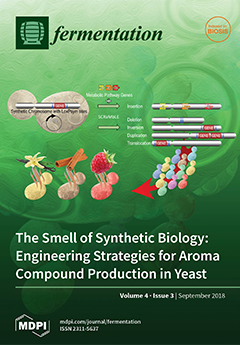Candida stellata is an imperfect yeast of the genus
Candida that belongs to the order
Saccharomycetales, while phylum
Ascomycota.
C. stellata was isolated originally from a must overripe in Germany but is widespread in natural and artificial habitats.
C. stellata is a yeast with a taxonomic history characterized by numerous changes; it is either a heterogeneous species or easily confused with other yeast species that colonize the same substrates. The strain DBVPG 3827, frequently used to investigate the oenological properties of
C. stellata, was recently renamed as
Starmerella bombicola, which can be easily confused with
C. zemplinina or related species like
C. lactis-condensi. Strains of
C. stellata have been used in the processing of foods and feeds for thousands of years. This species, which is commonly isolated from grape must, has been found to be competitive and persistent in fermentation in both white and red wine in various wine regions of the world and tolerates a concentration of at least 9% (
v/
v) ethanol. Although these yeasts can produce spoilage, several studies have been conducted to characterize
C. stellata for their ability to produce desirable metabolites for wine flavor, such as acetate esters, or for the presence of enzymatic activities that enhance wine aroma, such as β-glucosidase. This microorganism could also possess many interesting technological properties that could be applied in food processing. Exo and endoglucosidases and polygalactosidase of
C. stellata are important in the degradation of β-glucans produced by
Botrytis cinerea. In traditional balsamic vinegar production,
C. stellata shapes the aromatic profile of traditional vinegar, producing ethanol from fructose and high concentrations of glycerol, succinic acid, ethyl acetate, and acetoin. Chemical characterization of exocellular polysaccharides produced by non-
Saccharomyces yeasts revealed them to essentially be mannoproteins with high mannose contents, ranging from 73–74% for
Starmerella bombicola. Numerous studies have clearly proven that these macromolecules make multiple positive contributions to wine quality. Recent studies on
C. stellata strains in wines made by co-fermentation with
Saccharomyces cerevisiae have found that the aroma attributes of the individual strains were apparent when the inoculation protocol permitted the growth and activity of both yeasts. The exploitation of the diversity of biochemical and sensory properties of non-
Saccharomyces yeast could be of interest for obtaining new products.
Full article





